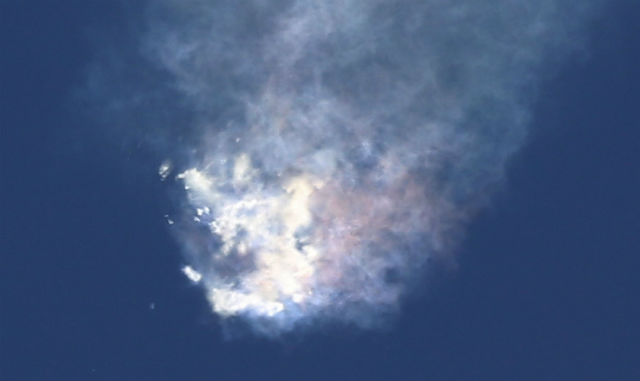Flights to the International Space Station are expected to continue as scheduled despite the total loss of Sunday’s resupply mission, though it may be months before SpaceX’s Falcon 9 rockets can return to flight.
Speaking hours after an uncrewed Falcon 9 resupply rocket exploded over the Atlantic some 139s after lift-off from Cape Canaveral, with the loss of its Dragon capsule laden with food, water, supplies and scientific experiments, NASA’s head of human spaceflight operations, Bill Gerstenmaier, said the launch of a Russian Progress cargo ship scheduled for 3 July would go ahead.
After that, he added, the Japanese space agency is scheduled to launch its HTV5 cargo ship in August, and two crew missions – on 22 July and 1 September – are also not affected by the loss of the seventh SpaceX resupply mission.
However, the SpaceX loss was the third failed ISS resupply attempt since October 2014, when an Orbital-ATK Antares rocket carrying that company’s Cygnus cargo vehicle blew up seconds after lift-off from Wallops Island, Virginia. A Progress mission was also lost after its 28 April launch, which left the vehicle out of communications in an uncontrolled orbit before crashing into sea.
Echoing remarks he made following the Orbital-ATK Antares loss, Gerstenmaier said: “Spaceflight’s not easy.” He added that NASA cannot plan for 100% success, and that “there was no commonality across these three events except it’s space and it’s difficult to go fly.
“We’re essentially operating systems at the edge of their ability.”
SpaceX, which operates ISS resupply flights for NASA as a commercial contractor, designs, manufactures and operates Falcon 9 rockets and Dragon capsules, and will lead the accident investigation with FAA oversight. SpaceX president Gwynne Shotwell said initial indications were that the first-stage flight went well, followed by an “overpressure event in the upper-stage liquid oxygen tank”.
Telemetry continued for some time from the Dragon capsule, she added.
SpaceX, said Shotwell, expects Falcon 9 rockets to be out of action pending analysis for some months but not as long as a year.
Meanwhile, the three-person crew currently on the ISS is in no danger. NASA’s ISS programme manager, Mike Suffredini, says there are adequate provisions aboard for a full crew of six until late October, and the Progress mission later this month should extend that by about a month.
The lost SpaceX flight was carrying scientific payloads – some of which were replacements for materials destroyed in the Antares explosion – and three astronauts currently in orbit cannot now maintain the station’s planned research workload. So, replacing the three crew members who returned to Earth earlier this month – and whose stay was extended by a month owing to April’s Progress failure – remains a priority.
Ultimately, says Suffredini, mission planning assumes continued crewing of the station unless food, water and other provisions drop below about one-and-a-half months’ supply. In that case, there are always return capsules berthed to the station.
For now, he says, the astronauts on board need to “watch water”, as one important item lost in the SpaceX explosion was as replacement water filter for the recycling unit. Those filtration beds, he adds, are slow to make, so it is unlikely that NASA will have one ready for the August flight of HTV5 – which, like this week’s Progress capsule, will be loaded with fresh water.

Oh dear!
Rex Features
Gerstenmaier also downplayed any concerns that this accident might derail NASA’s plans to begin US flights to the station from 2017, with a crew-rated version of SpaceX’s Dragon and Boeing’s CST-100 capsule to supplement Russian-operated Soyuz flights – which have been the only route to the ISS since the 2011 retirement of the Space Shuttle fleet. Again recalling remarks he made following the Antares loss, he said that cargo flights could “tolerate more risk” than crew flights, and lessons learned from a failure might even expedite progress towards US-operated crew flights.
However, Gerstenmaier had a dig at the lawmakers in Washington who have cut the budget for NASA’s so-called Commercial Crew programme. There remain technical problems to solve before either Dragon or CST-100 can fly but “we need full funding”.
To cut funding now and make it up later, he said, was not possible: “We cannot compress or delay technical work.”
Source: FlightGlobal.com
















